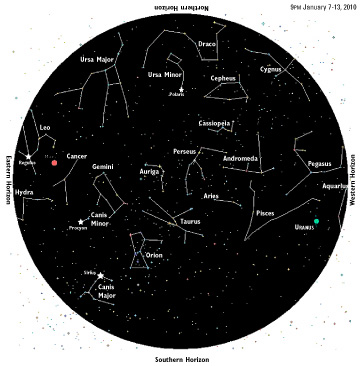Chesapeake Bay's Independent Newspaper ~ Since 1993
1629 Forest Drive, Annapolis, MD 21403 ~ 410-626-9888
Volume xviii, Issue 1 ~ January 7 - January 13, 2010
Home \\ Correspondence \\ from the Editor \\ Submit a Letter \\ Classifieds \\ Contact Us
Dining Guide \\ Home & Garden Guide \\ Archives \\ Distribution Locations \\ Advertising
![]()


Sky Watch

by J. Alex Knoll
The Planetary Parade
While the moon wanes, the planets shine
This week the sun sets after 5:00, revealing Jupiter high in the southeast, a steady golden glow brighter than any other object. This nighttime beacon currently sets a little after 8:00, but it will disappear amid the sun’s glare by Valentine’s Day.
As Jupiter sinks toward the horizon, Mars rises at the opposite edge of the sky. While nowhere near as bright as Jupiter, it is still one of the brightest lights in the sky and easily outshines its neighbors in the northeast.
The nearest light brighter than Mars is to the south, where Procyon in Canis Minor twinkles. Still farther to the south, Sirius, the brightest of all stars, shines above the southeast horizon. Unlike planets, whose light is relatively close and thereby appears as a steady glow, starlight travels millions upon millions of miles to reach our eyes, and it is distorted over the vast distance, causing it to twinkle. When a star is as low against the horizon as Sirius, its light is all the more disrupted by earth’s atmosphere, causing it to shimmer and dance, changing color and hue in the process.
As midnight approaches, Mars is high in the east, trailed by blue-white Regulus, the heart of Leo the lion. Around the same time, Saturn crests the east horizon amid the stars of Virgo. The bright blue star Spica follows about 15 degrees in the planet’s wake. In a telescope, Saturn appears as a slightly bulging orb, as its rings are still facing us nearly edge-on.
In the early morning Friday, look for Spica shining above the waning moon. The moon rises in the wee hours before dawn this week. By Monday it doesn’t rise until 5am, when it hovers less than one degree above the red-giant Antares. Tuesday’s moon rises a little before 6am, and is now some 10 degrees behind Antares; Equidistant below the moon is Mercury, so close to the rising sun that you’ll need binoculars to spot it.
Illustration: © Copyright 1925 M.C. Escher/Cordon Art-Baarn-Holland; Graphics: © Copyright 2009 Pacific Publishers. Reprinted by permission from the Tidelog graphic almanac. Bound copies of the annual Tidelog for Chesapeake Bay are $14.95 ppd. from Pacific Publishers, Box 480, Bolinas, CA 94924. Phone 415-868-2909. Weather affects tides. This information is believed to be reliable but no guarantee of accuracy is made by Bay Weekly or Pacific Publishers. The actual layout of Tidelog differs from that used in Bay Weekly. Tidelog graphics are repositioned to reflect Bay Weekly’s distribution cycle.Tides are based on National Oceanic and Atmospheric Administration and are positioned to coincide with high and low tides of Tidelog.
© COPYRIGHT 2010 by New Bay Enterprises, Inc. All rights reserved.
